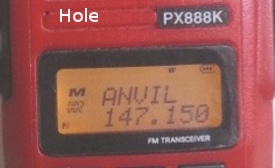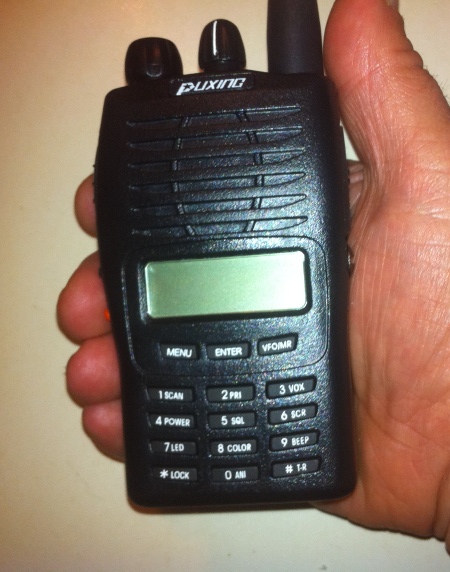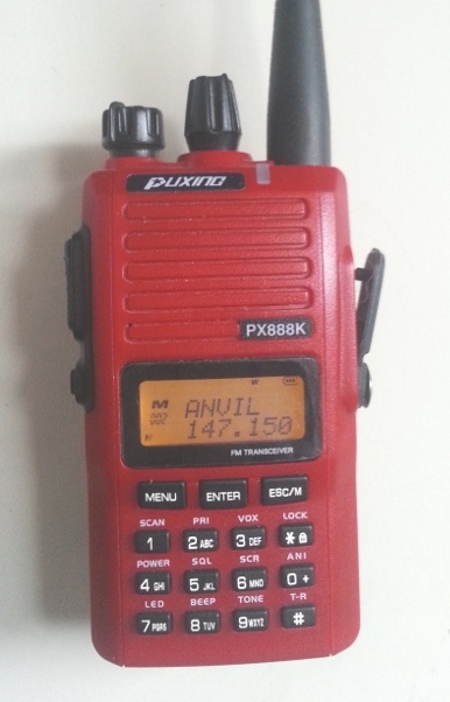Comparisons and Details
Software Defined Radios
These are software defined radios. There is one big computer chip inside them,
and some r.f. circuitry, but for the most part the radio simply takes the r.f.,
slices and dices it for digital processing. There are analog amplifiers for
audio in and out. All buttons, knobs, display, backlight etc. are hardware pins
on the CPU chip.
This type of design allows the manufacturer to make minor or drastic changes in
the innards of the radio, its frequency coverage and performance. Some changes would
require new button and/or front panel labeling.
Unlike more conventional radios, this type of design allows a factory to be set to
produce a circuit board and innards for a variety of radios, and with the addition
of software, plastic case and a couple other items, call it Model so-and-so. This
means that production remains stable for quite a while, making these radios cheap to
produce.
In China and other various asian countries, they have such radio services as our
Family Radio Service, but on different UHF frequencies. These radios look totally
different, they may or not have a touch pad. But the guts are the same!
This also means that you can expect the PX-777+ and the PX-888K to be followed
sooner or later with newer models, differing only in software. One possible change
is that the new FCC rules for commercial services require the radios to be shipped
with only Narrowband modulation allowd. Expect some sort of software change. If
done properly, the Ham bands will be able to use Wide modulation, and the rest of
the radio band (outside the ham band), to use only Narrowband modulation. Exactly
how this will be implemented is not clear; and I will write about it when I find out.
The Accessories
These Puxing radios have a two-pin microphone connector. It is the same as the
two-pin Kenwoods, so the Kenwood accessories will work fine on the Puxing's and
vice versa. Some other chinese brands have the same pinout.
Both radios have the industry standard SMA connector. Male on the radio, with
internal threads, and Female on the rubber duck antenna, with external threads.
I am often asked, how come it is male with internal threads?
The answer is that the threads have NOTHING to do with the gender of any
connector. The gender is defined by the center pin, male or female.
This antenna gender is pretty much an industry standard for the SMA connector.
But you should be aware that Yaesu implements it backwards! Thus,
antennas and adaptors made for Yaesu will not fit each other. Not
following standards has been a feature of Yaesu, and they are the ones with weird
microphone connectors, antennas etc etc that work only with the Yaesu/Vertex stuff.
Yaesu Vertex is not a particularly noted manufacturer of commercial radios, although
with their heavy handed advertising have secured a strong foothold in the Amateur
market.
The Puxing's and many other Chinese and Commercial brands follow the same
standard: the one Yaesu does not!
The battery for these radios are Lithium Ion Oxide or LiPO batteries. They are
rechargeable. Lithium is a rare earth that is extensively mined in China, whereas
in the USA mining is almost a dead industry. As a rule, Chinese made batteries
are inexpensive and perform very well indeed.
Both radios share the same battery. You get the standard 1,200 MAH battery when
you buy the radio; there are aftermarket and Puxing units rated at 1,600 MAH.
When I tested the PX-777+, I got 36 hours of standby time, with about a 60
second transmission every hour while I was awake and home. I figured 15 to 20
such transmissions. At the end of the 36th hour I was unable to make any further
transmissions, although the unit continued to receive/standby for another hour or
two. I call this performance as "36 hours" because it represents a typical use
of the radio and battery during an outing.
I did not test the 1,600 battery for usable hours, but I would expect it to be in
the 48 hour region.
The PX-888K uses up more battery power, and I would expect only 20 - 24 hours
of standby/on from the stock 1,200 battery, and perhaps 30-36 from the 1,600.
The supplied charger is intelligent, and will not cook the batteries. You can
leave the radio in the charger indefinetely. Also these batteries have a longer
longevity than brand Y. The Puxing batteries are now well over year old here,
and none have failed, whereas brand Y batteries often give up the ghost after a
few months.
Perhaps if these radios have a flaw is that the batteries do not attach very
firmly to the radio. I have had a few pop off. What I discovered is that if you
inspect the latch mechanism of the radio and the battery, you can see that some
are warped this way or that, but that it is possible to get them to work properly
if you use your brains and work on it yourself.
Lastly, unlike brand Y batteries that like to cost $35 - $70 each, these
Puxing Batteries run $11 - $20.
Much is made by Yaesu of their waterproof construction. Some of this is relative.
If you leavea rubber plug or cap off, it is no longer watertight. They get a lot
of money for this feature.
The Puxings here in Nome have fallen on water puddles, completely submerged for
a few seconds, with no ill effect. My advice is not to take a chance and in the
rain put the radio inside your coat pocket. But it is good to know that a radio
that gets a bit wet will not fail immediately.
There are a colossal variety of mikes, headsets, bone mikes, throat mikes, etc.
available for these units. Some are flimsy affairs indeed, and if it seems too good
a deal to be true, probably is! However, at the prices asked on eBay, it would be
worthwhile to experiment.
I have ordered a couple of regular hand mikes, but when I saw the "Rainproof" mike,
I got one. Then another one. I have several now. They are indeed rainproof, and
make carrying your radio inside your coat very practical. Alas, they are not
freeze proof and if they get cold soaked, the push to talk rubber membrane gets
so stiff that you don't know if your were transmitting; or vice versa. Perhaps this
will be fixed in the future.
You *need* a hand mike! I do not make this statement idly. The usefulness
of a Handheld radio is enhanced by a hand mike. It frees your hands, you can drive,
cook, eat, etc with a handmike clipped to your lapel. You can attach the radio to
something sturdy inside your car, and reach for and drop the mike as needed. You
would be loath to drop a whole radio inside a vehicle, specially an ATV. The mike
will just dangle from its coiled cord. You will find infinite uses for a hand mike.
Some specifics on the radios
 Displays. The PX-777+ has a single line display while the PX-888K
has a two line display. Displays. The PX-777+ has a single line display while the PX-888K
has a two line display.
This means that for any given channel, the PX-888K can display more information
about that channel.
The PX-888K display shows to lines, one line says "ANVIL", which is the name of
the channel, and the second line "147.150" which is the receive frequency of the
radio.
This is a great feature of the PX-888K over the PX-777+, and to me, a great selling
point!
[Note: The tiny hole labeled Hole in the picture is the hole for the microphone.
When you speak, the sound from your mouth goes into this hole and into the microphone. Some
radios are reported to have low or weak transmit audio. Making this hole ever so slightly
larger will fix that. You can dissasemble the radio, or just drill it so carefully that you
don't drill into the mike!]
You can set your radio to display channel name, channel number, receive frequency.
In the 777+ you can only display one of these at a time, but on the 888K you can display
any two. Furthermore, on the 888K you can display TWO frequencies, or channels etc
when the radio is in "Dual Watch Mode."
Dual Watch. Please do not confuse this with "scanning" or scanning two
channels. In scanning, the radio changes from one frequency or channel to the next
on the scan list. You can scan any number of channels, you can add or delete channels
to the list, and you can set any channel to be priority. Priority means that the
radio will scan the list, but between each step will check the priority channel.
Example, you have your radio set to scan CH-001, CH-002,CH-003, CH-004 and CH-005.
In regular scan it will go 1-2-3-4-5-1-2-3-4-5-1-2-3-4 ... etc.
If you designate channel CH-001 to be priority, then the scanning will be
1-2-1-3-1-4-1-5-1-2-1-3-1-4 ... always checking back to the priority channel.
Both radios can do scanning. In dual watch, which only the PX-888K can do,
the radio will receive TWO channels at the same time. This is because the PX-888K has
two internal simultaneous receivers. It receives two channels at the
same time. You can set this up in a number of ways: You could mix both channels
on the speaker and when both channels are active you will get a jumble of the two
voices. Or you could set one channel to mute the other channel when it is
active.
Dual watch channels are designated A and B. The A or the B is only displayed
when that channel is the master one; ie, the one that mutes the other:
A 147.150
147.270
or
147.150
B 147.270
or
A 147.150
B 147.270
In the three examples above, you will see that 147.150 is master on the
first example, secondary on the second example, and mixed up on the last example.
There is no reason instead of displaying 147.150 you could not display "Anvil".
Or CH-007.
When only one letter is displayed, that will be your Transmit channel, it will
never transmit on the non lettered one. I am not sure on the behaviour on the
third example.
Now, you may ask, how is that different from just scanning two channels?
Good question! Mainly in that scanning involves a delay while the radio
changes channels. First it tunes in the first channel, then the internal computer
tells it to change channels. When it does, the new frequencies and parameters
are set up and the command is given to change. This change takes a bit of time;
perhaps close to one second. Thus, scanning is slow, and there is a discernible
delay as the radio steps thru the channels.
With dual watch, there are already TWO radios in there ALREADY set up so the
switching is instantanous; in fact, there is really no switching as both radios
are receiving simultaneously.
The PX-777+ has only a single receiver and does not have dual watch. But it
will scan and priority scan.
FM Broadcast Reception
The PX-888K but not the PX-777+ receives FM broacasts, like KICY-FM.
They will not receive AM or TV sound signals. The received
FM station can be one of the ones for dual watch. You can be listening to
Beethoven's Third Philarmonic on FM, when a call comes in. The music stops,
the radio call on the ham channel comes through the speaker. There is a delay
before it resumes
listening to FM music. This allows you to start talking. After the QSO is
finished, and a brief delay, the music comes out the speaker again.
Programming the Beasts!
Although the two radios are closely related, they differ in some regards.
You can program the radios using a computer, and a table of details much like
an Excel spreadsheet. If you are managing more than a handful of channels, this is
much easier to do than keyboarding channel information.
Programming from a PC requires a programming cable and software. The cable
costs about $15, and the software is free. While the cable and the driver for
the cable is the same for either radio, the Excel-type programming software is
different for each model. This cable will also program other Chinese radios and
some Kenwoods.
If you are programming from the radio keyboard itself, the PX-777+ wins hands
down as it has the self programming mode. Basically, self programming means
that when you enter that mode, you select the channel and the radio will ask you
questions about that channel that you enter, and then step to the next question
until done.
Both radios will support a VFO mode, and the VFO selected parameters can be
assigned to a specific channel.
How to do all this is beyond the scope of this article, but will be featured in
subsequent articles.
Copyright © 2013, Ramon Gandia. All rights reserved.
| 

 Displays. The PX-777+ has a single line display while the PX-888K
has a two line display.
Displays. The PX-777+ has a single line display while the PX-888K
has a two line display.